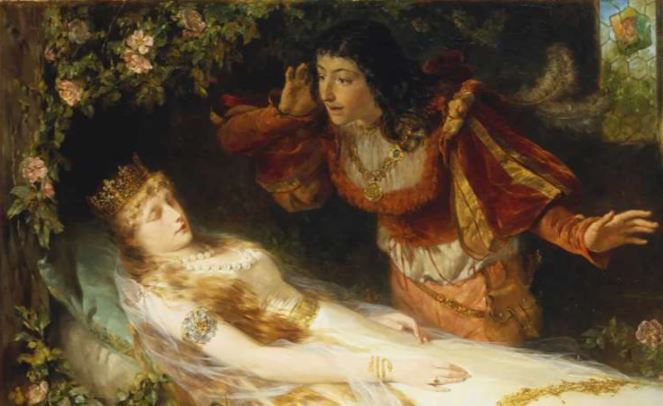
Sleeping Beauty waking up with a prince kiss is a tale millions of kids have enjoyed through the ages. In fact, the story has been enjoyed for many more years than people think! We all know the Disney’s 1959 version which awed a generation with its colorful animation and memorable songs. Yet, Walt Disney used a very ancient story that has been around for centuries and possibly more.
The Birth of The Waking Sleeping Beauty
The fairy tales that we know are often a result of much older stories that have evolved through time. Love and scary stories alike have been told and passed on verbally for generations. As a result, due to the lack of written records the origins of popular tales have been lost. In the case of the waking up of Sleeping Beauty we actually have a very ancient written version that seems to be one of the grandparents of the story we know.
The Great Harris Papyrus of Egypt
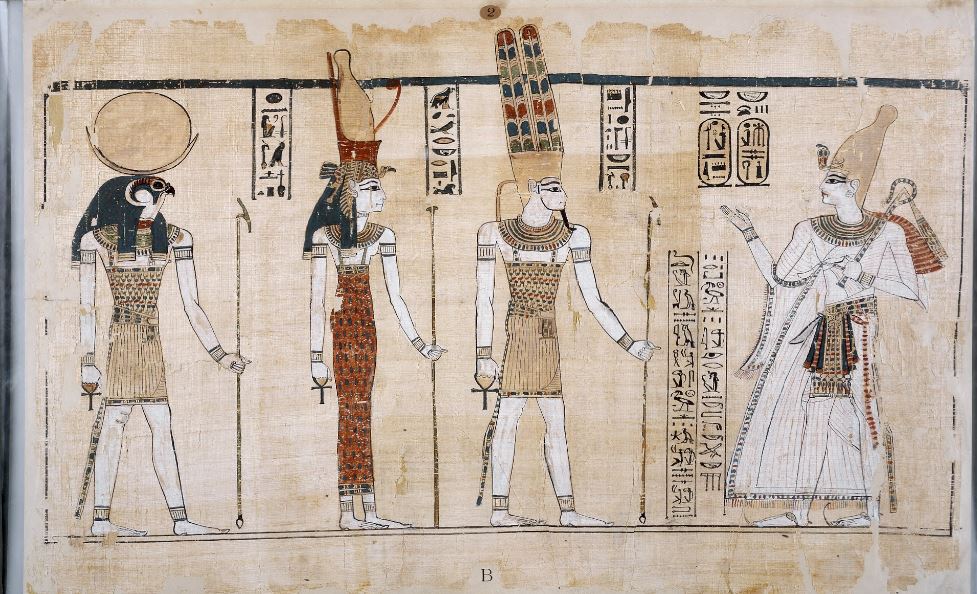
The Great Harris Papyrus is the longest surviving Egyptian papyrus. This incredible document includes the story of a King desperate to have a son. He prays the gods and his wish is granted. The night the prince is born Hathors (goddesses who predict the future at birth) foretell his future and his early death. The King afraid for his son’s safety builds a castle to isolate and protect his son. Eventually the son, hiding from the father, falls in love with a princess and marries her. The princess saves the curse prince from imminent death, but unfortunately at this point the papyrus is interrupted. Although the gender is reversed, the birth of a prince, the foretelling of fairies, the hiding and the redemption through love are all essential elements present in the Sleeping Beauty story.

The German Sleeping Beauty
Although the first version of a waking sleeping beauty were told in Egypt and later in Italy and France, Sleeping Beauty is often considered a German tale. In fact, the connection to the 1200s Brunhild legend is very strong. Usually, Brunhild normally appears as a warrior queen, a shieldmaiden, or Valkyrie. In the tale Edda, Sigurd rescues a sleeping Brunhild in armor. Contrarily to the classic waking up of Sleeping Beauty, this story ends in tragedy but there are many other similarities. For example, the “Prince” has to go through a wall of fire in order to wake up the Sleeping Beauty. Similarly, in the classic Sleeping Beauty the Prince needs to go through a wall of thorns before he can wake up the future Queen.
The Evolution of waking up Sleeping Beauty
The Shocking Perceforest Sleeping Beauty
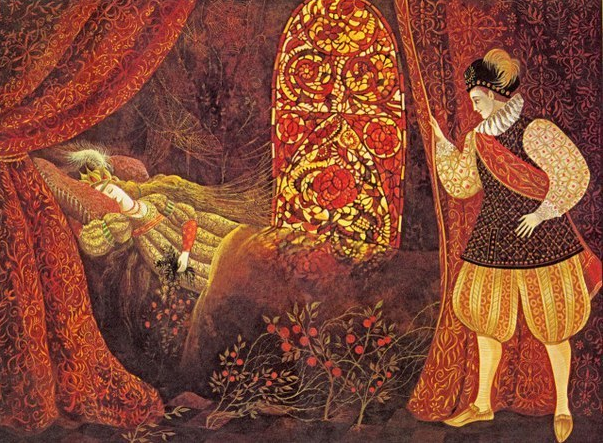
The first written account that resembles more our waking up of Sleeping Beauty story is found in Le Roman de Perceforest, a 1300s narrative collecting many folkloristic tales.
In this story when the princess is born, three goddesses are invited to celebrate the birth of the newborn. One of the goddesses is upset that her cutlery is not as beautiful as that of the other two. She curses the baby through stabbing her finger with a piece of flax and the princess goes into an eternal sleep. At the end of the tale a prince falls in love with her but is unable to wake her up. The prince decides to stay by her and eventually she gives birth to a child while still asleep. The new born son sucking on the mother’s finger removes the flax and the princess wakes up. This details are definitely shocking and not very family friendly for our days, yet this is the first western version of Sleeping Beauty
The Basile Gruesome Sleeping Beauty
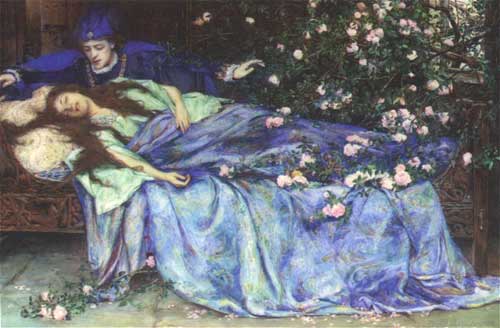
Giovanni Basile in 1636 tells the tale in Sun, Moon, and Talia.
In this version, wise men and astrologers predict the future of the princess telling the father that she will be in danger from a splinter of flax. Eventually, the splinter seems to cause the princess death, who in reality is only a deep sleep. The Father desperate leaves his daughter on his throne and abandons the palace. Later on, another King knocks on the palace, and when he receives no answer, walks into the Castle and finds the princess. He falls in love and “gathers the first fruits of love”. Nine months later she delivers twins who sucking on her finger remove the flax. The King, father of the twins, returns to visit the sleeping princess and finds her alive. The King explains what happened and they fall in love. In a series of events, the real wife of the King tries to kill the twins and feed them to the King. The Cook saves the day and the evil Queen ends up being burned instead. The Princess and the King marry and live happily ever after.
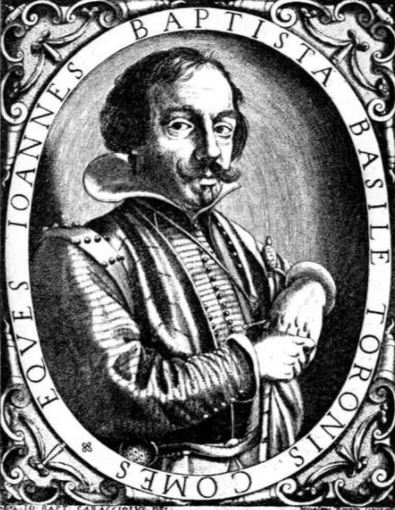
The Slightly Improved Perrault waking up Sleeping Beauty Story
Only a few decades later Perrault used the Basile’s story modifying it slightly. In this story the fairies are seven. Everyone thought that the older fairy was dead so the palace did not prepare a meal for her. The old fairy feels insulted and curses the princess to a premature dearth. Fortunately, the last fairy still has to give her gift and reverses the death into an eternal slumber. In order to stop the curse, the King removes all the spinning wheels in the kingdom. Sadly, one is left and when the sixteen year old princess eventually finds it she starts using it until a splinter pokes her and she falls asleep. Much later, a prince hears of the tale, walks into the castle, and kisses the princess waking her up. The prince and the princess end up talking and falling in love, marrying, and having kids. The story doesn’t end, however, as the Ogre mother of the prince wants to dispose of the babies and the princess in a feat of jealousy. Once again, it is the cook who saves the day. The King and now Queen live happily ever after.
The Final Grimm Brothers’ Sleeping Beauty
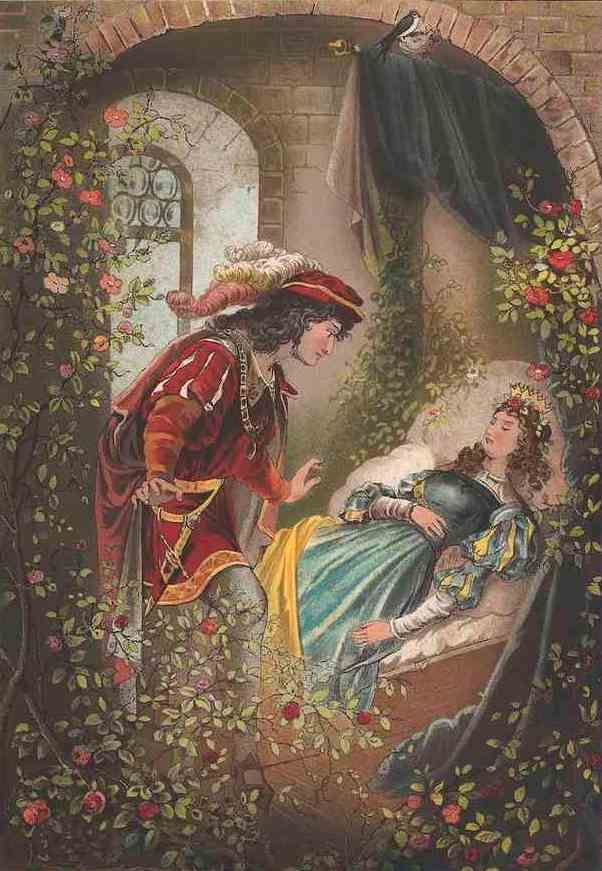
The Grimm brothers included a version of Sleeping Beauty derived for Perrault’s version. In their version they include only the first part of the story, until the princess awakes. In addition, the fairies are substituted by thirteen wise women. Another key difference is evident in the curse. In this version, the princess is cursed to sleep 100 years and during that time many different princes try and fail to wake her. Only when the 100 years are almost up, a prince is allowed through the protecting thorns and is able to awake the princess. The second part of the story is told in another tale called “The evil Mother-in-law”. The Basile and Perrault story most likely did combine two stories into one in their account.
The Name of Sleeping Beauty
The name of Sleeping Beauty changes in almost every version. We all know her as Aurora from Disney. However, in Basile’s version she was Talia, in Perrolt version she has no name and the Grimm brothers call her Aurore.